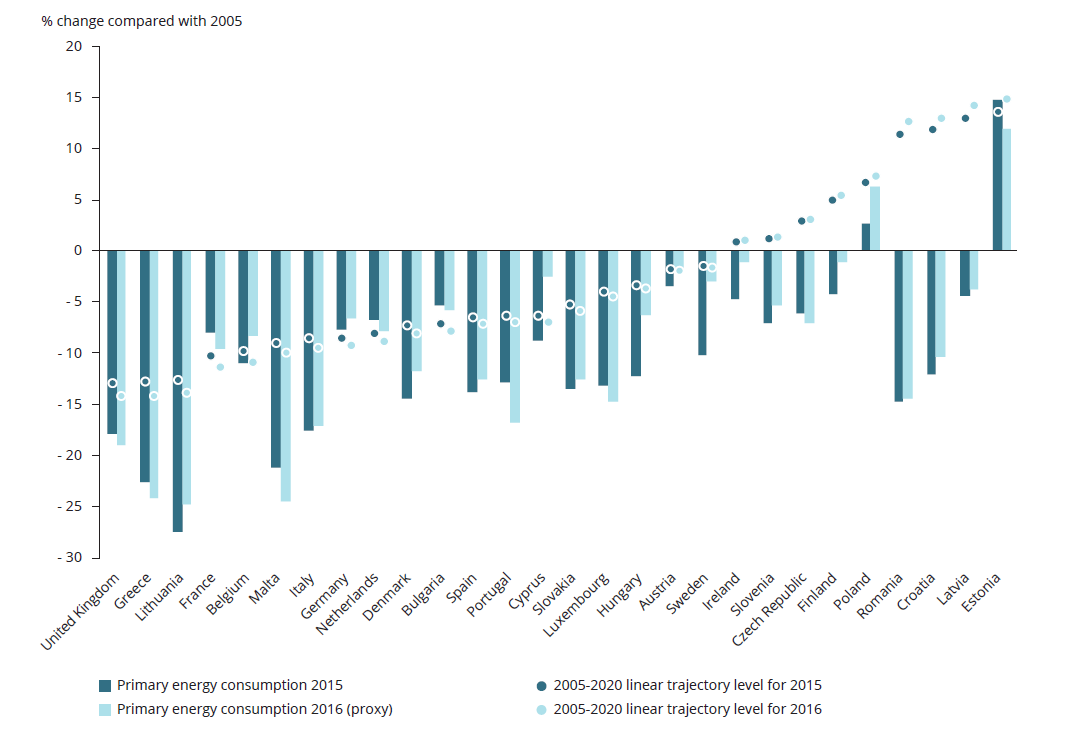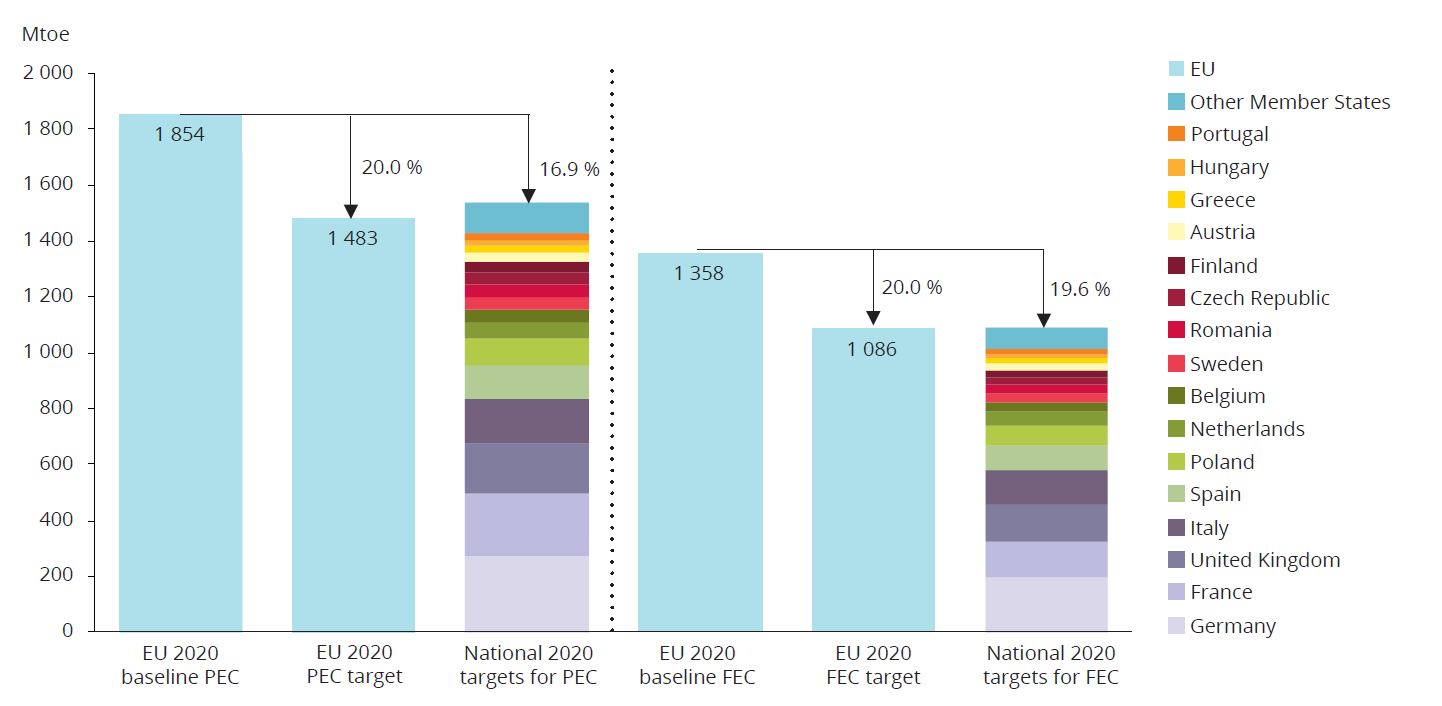7.1 Progress towards national primary energy consumption targets
Member States set their own national non-binding targets for energy efficiency, which can be based on absolute primary or final energy consumption, absolute or relative primary or final energy savings or on energy intensity. The EED requires, however, that when doing so, Member States also express those targets in terms of absolute levels of primary and final energy consumption in 2020 (EU, 2012) [1].
For primary energy consumption, the targets range from a 19.4 % reduction (the United Kingdom) to a 20.3 % increase (Estonia), compared with 2005 levels. A total of 19 Member States have set targets to decrease primary energy consumption. The other nine Member States (Croatia, Czech Republic, Estonia, Finland [2], Ireland, Latvia, Poland, Romania and Slovenia) have set targets that are higher than their 2005 primary consumption levels [3]. Member States can also revise their targets and projections upwards or downwards at any point. In fact, the 2017 national energy efficiency action plans NEEAPs [4] available from 18 Member States at the time of writing show that several countries appear to have revised their 2020 targets expressed in primary energy consumption to higher (less ambitious) absolute values.
Comparing primary energy targets reported to the Commission up to 2016 with absolute target levels reported in the 2017 NEEAPs, three Member States (Ireland, Sweden and the United Kingdom) have revised upwards their absolute levels for primary energy consumption, whereas one country (Slovenia) has revised their absolute levels downwards.
As neither Member States nor EU legislation set any indicative trajectory to monitor the progress of Member States towards their national 2020 targets, this analysis tracks progress towards energy efficiency targets by considering, for each Member State, an indicative linear trajectory between primary energy consumption levels in 2005 and 2020 targets, and by comparing the absolute levels of primary energy consumption in the assessment year with this linear trajectory. According to the EEA's methodology, a country is considered to be on track towards meeting its 2020 target if its primary energy consumption for 2015 is on or below its linear trajectory. Conversely, a country with primary energy consumption levels above its linear trajectory is considered not on track and needs to reduce or limit its energy consumption at a faster pace to meet its 2020 objective. Final energy consumption trends are also discussed in Section 7.2, below, to provide insights into energy consumption trends that are as complete as possible. However, final energy information is not used to track progress in the present assessment.
Between 2005 and 2015, primary energy consumption decreased in 26 Member States and increased only in Estonia and Poland. Twenty-three Member States reduced (or limited the increase in) their primary energy consumption to levels below their corresponding linear trajectories in 2015 (see Figure 7.1). If maintained until 2020, the pace of reductions (or limited increases) observed since 2005 should allow these countries to meet their 2020 targets. However, recent trends in primary energy consumption in several countries [5] raise uncertainty as to whether or not the 2020 targets will be met. In five countries (Bulgaria, Estonia [6], France, Germany and the Netherlands), primary energy consumption in 2015 was above these countries' linear trajectories. This was already the case in 2014 for Estonia. Conversely, while Malta was above the linear trajectory in 2014, its primary energy consumption in 2015 was below the trajectory.
In 2015, 22 Member States were already below their 2020 targets. The exceptions were Belgium, Bulgaria, France, Germany, the Netherlands and the United Kingdom.
According to preliminary EEA data for 2016 on primary energy consumption, three additional countries (Austria, Belgium and Cyprus) exceeded their linear trajectory threshold in 2016, in addition to the five above mentioned countries that were not on track in 2015. Estonia is expected to be back on track according to 2016 estimates.

Note: The figure compares, for each Member State, primary energy consumption levels for a given year and the level of the indicative linear trajectory between 2005 and the relevant 2020 target on primary energy consumption.
Sources: EC, 2017d, 2017e; EEA, 2017h; Eurostat, 2017b, 2017c.
7.2 Trends towards national final energy consumption targets
National indicative 2020 targets for final energy consumption set by Member States under the EED range from –21.0 % (Hungary) to +65.8 % (Malta), compared with 2005 levels. Many Member States have updated their absolute target levels for final energy consumption in their 2017 NEEAPs, where these have been made available[7]. Four countries revised their absolute consumption target levels upwards (Cyprus, Ireland, Sweden and the United Kingdom).
In 2015, 19 Member States were in line with or below their linear final energy trajectories. However, Austria, Belgium, Bulgaria, France, Germany, Hungary, Lithuania, Malta and Slovakia had not sufficiently reduced their final energy consumption to stay below their linear trajectories. This is a significantly different situation from 2014, where 24 Member States were in line with or below their linear final energy trajectories.
7.3 Aggregated ambition level of Member States' national 2020 targets
In the NEEAPs submitted by Member States in 2017 [8], absolute target levels for primary and final energy consumption have been revised to higher values in several cases, signalling that efforts to meet European targets might be slowing.
Taken together, the sum of all individual 2020 targets for primary energy consumption add up to 1 540 Mtoe, which is 3.8 % higher than the EU target (1 483 Mtoe) (see Figure 7.2).
For final energy consumption, the sum of Member States' 2020 targets adds up to 1 091 Mtoe, 0.4 % higher than the EU target for final energy consumption (1 086 Mtoe) (see Figure 7.2).
Therefore, contrary to the situation observed in 2014 (EEA, 2016), achieving these national targets would not be sufficient to reach the EU-level target for final energy consumption. This is a direct consequence of the 2017 revision of the targets by nine Member States and introduces further uncertainty to the tracking of progress at the EU level.

Note: The Member States grouped as 'Other Member States' are those that have a 2020 target for primary energy consumption lower than 20 Mtoe and a 2020 target for final energy consumption lower than 15 Mtoe. In order of decreasing magnitude of 2020 targets, these countries are Denmark, Bulgaria, Slovakia, Ireland, Croatia, Slovenia, Estonia, Lithuania, Latvia, Luxembourg, Cyprus and Malta.
FEC, final energy consumption; PEC, primary energy consumption.
Sources: EC, 2017d, 2017e; EU, 2012.
Footnotes
[1] Together these targets should contribute to achieving the EU's objective of reducing energy consumption by 20 % by 2020. However, a challenge in assessing EU progress is that the aggregation of individual Member States' targets does not add up to a 20 % EU-level reduction in energy consumption by 2020. > Back
[2] For Finland, this is explained by exceptionally low energy consumption in 2005 compared with other years. > Back
[3] The absolute target levels of primary and final energy consumption in 2020 reported by Member States under the EED, allow the EEA to assess progress towards energy efficiency targets consistently across Member States. Member States themselves may monitor their progress to target following a national approach. > Back
[4] By the time this report was finalised, not all Member States had published the final version of their 2017 NEEAPs, meaning that 2020 Member State targets may still be subject to change. > Back
[5] In 2015, 17 of the 28 Member States increased their primary energy consumption relative to 2014. > Back
[6] Estonia reports on primary energy consumption targets, but it tracks progress based on final energy consumption. > Back
[7] The absolute target levels of primary and final energy consumption in 2020 reported by Member States under the EED allow the EEA to assess progress towards energy efficiency targets consistently across Member States. Member States themselves may monitor their progress to target following a national approach. > Back
[8] By the closing date for this report, the following countries had published their updated NEEAPs on the European Commission's website: Austria, Belgium, Bulgaria, Croatia, Cyprus, Czech Republic, Denmark, Estonia, Finland, France, Germany, Ireland, Latvia, Malta, Netherlands, Slovakia, Spain, Sweden and United Kingdom. > Back
Document Actions
Share with others